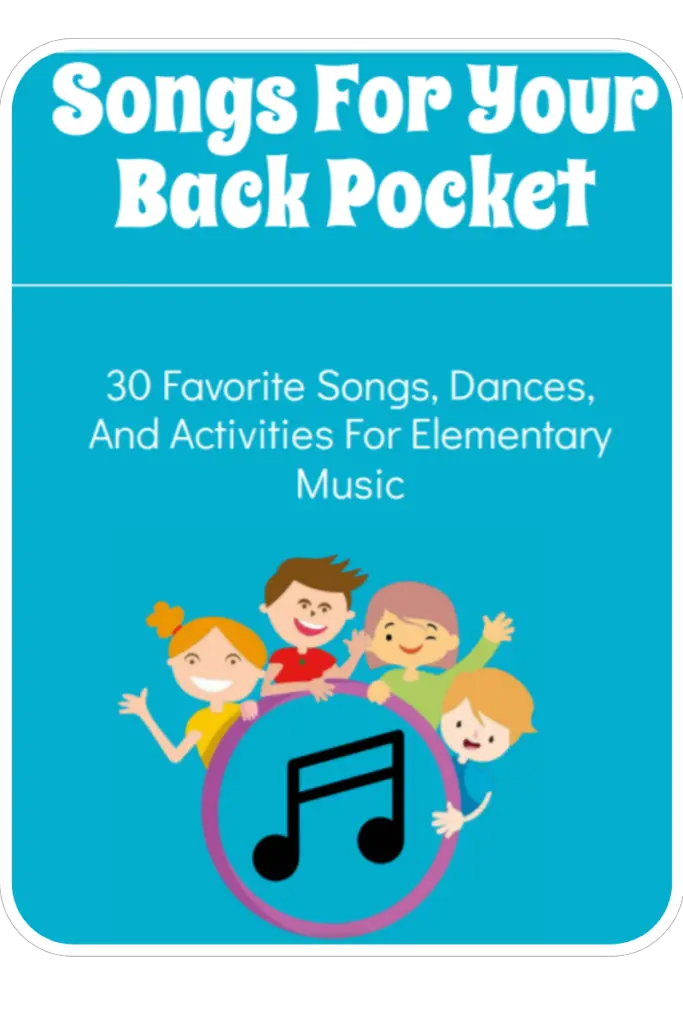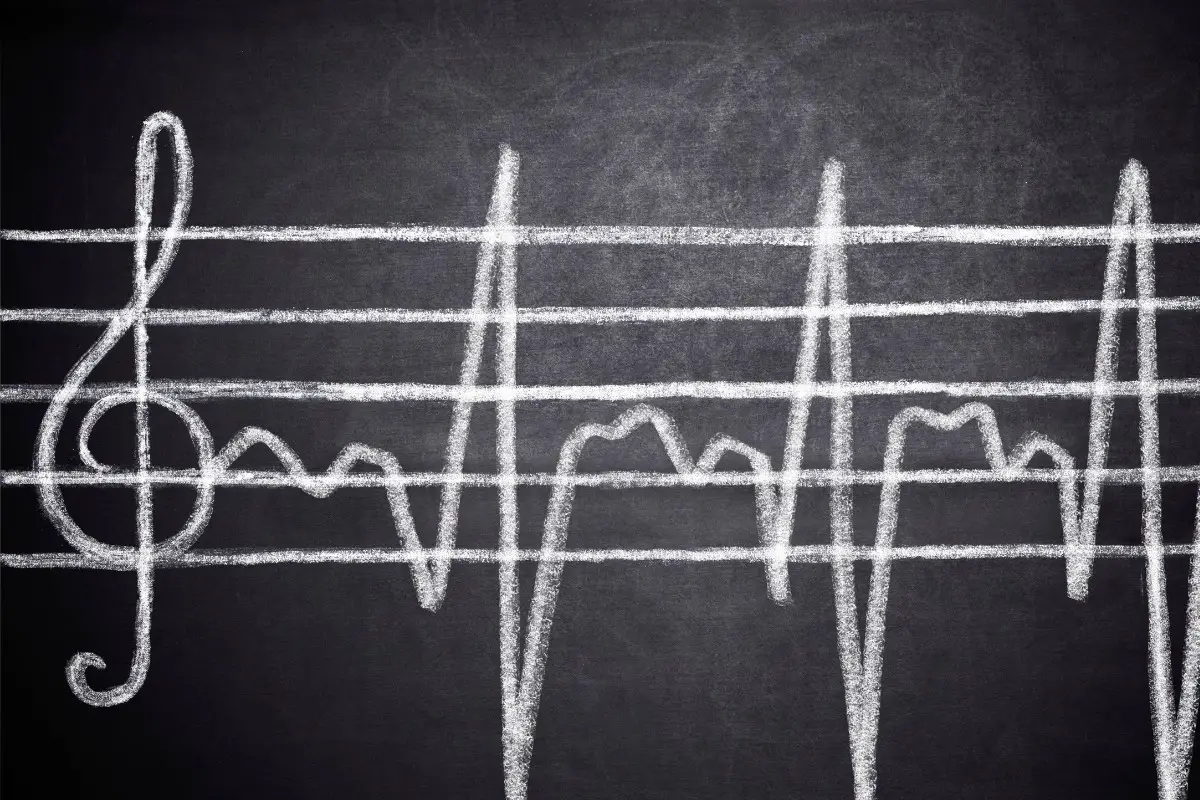Learning the treble clef note names is one of the main concepts most people start teaching their music students in third grade and above.
Doing so, provides the students a basis for reading and playing music even more later on.
I’m a big advocate for active learning and music making rather than worksheet practice, but let’s face it: Sometimes it’s easiest to use worksheet for individual or small group practice.
It shouldn’t be the bedrock of your teaching strategy, but it’s perfectly fine to use in moderation, especially if they’re engaging and well done!
With all this in mind, I looked around and found (or made) these 10 FREE treble clef note name worksheets.
All worksheets made with a combination of Flat.io and Canva.
Read on for details on each page.
Download The Whole Packet at the bottom of the page:

Save time with these 60 FREE Music Resources to use in your room right away!
Stop searching the whole internet to find good activities. I’ll help you cut to the chase with my favorite 60 FREE resources.
Table of Contents
#1 Simple Fill In the Treble Clef
This page is perfect for starting out with note names.
All they have to do is put the note names where the different notes go.
I use this one as a do-it-together before sending them off on their own to practice.
#2 Create Your Own Saying
The research on mnemonics and their usefulness has been called into question lately.
I get it to a certain extent.
I think it doesn’t help every single student, but I think it may help enough of them to be worth the time spent doing it.
Many of us know the common mnemonics for the treble clef:
For the lines:
- Every Good Boy Does Fine
- Elephants Go Backward Down Freeways
- Each Girl Break Dances Friday
The Space spells FACE from bottom to top.
I love to allow students choice and harness their creativity.
I bet you do too!
With this worksheet, small groups or individual students will get the chance to make their own mnemonic, and odds are, they’ll remember it for years to come.
#3 Fill In The Missing Letters
Here is a simple but effective one.
I like to use this one as a first independent worksheet.
Why? Because some of the answers are filled in.
One of the hardest parts of reading the G clef at first is how the farther down the system you go, the harder it gets to sort/place the letters.
With key notes filled in, it allows the students a chance to reset their placement and increase their chances of success.
#4 Write The Notes
Seeing the notes and then writing the note names may be challenging for some kids, but switching it around is even harder.
Here’s a worksheet I only use once they have a firm grasp on labeling the written notes on the staff.
They see a letter or note name and have to place it themselves.
Notice how this worksheet starts with a row of notes using only the spaces, then only the lines, and then both.
That’s a good tip for any musical concept, but especially when reading pitches.
Isolate different ideas for practice before moving on to put them all together.
#5 Solve The Words
I love puzzles, and I bet some or all of your students do too.
This is the same skill as filling in the blank from before, but now it’s done in the context of completing the missing word.
In a way, it’s also self-correcting.
The correct note is obvious when the word makes sense.
There are a ton of worksheets along these lines, and these make perfect sub plans for music classes.
If your students are confident enough in their reading skills, they don’t even need a true music sub to get this done.
Further Reading: Music sub plans (FREE)

Tired of searching and searching for songs that work?
I’m saving you headaches and wasted time spent looking for good activities with this eBook of my 30 favorite songs, dances, and activities for elementary music. Get back to making music right now!
#6 Mystery Songs In Treble Clef
One teaching tactic I see music teachers forget about all the time is how you need to connect the “reading” or “learning” parts of your music room with the “making music” parts of your classroom.
In my experience, one of the simplest ways to transition out of a learning chunk and into a game or playing activity is through a Mystery Song.
In this worksheet, students will need to write in the treble clef note names, as expected, but the twist is that each song is one I teach in class leading up to this.
You may know them as well, and there’s a good chance you also teach them!
Further Reading: Music lesson plan examples for elementary music
#7 Lines Vs. Spaces
Here’s a worksheet you may want to use early on in the teaching process.
This one isolates the lines and space notes with the treble clef and doesn’t put them together.
I don’t always use this one; I’ll often stick it in with classes that really seem to struggle.
Or, I’ll separate students into small groups and give the struggling students this one, while advanced groups get other ones.
This differentiation is important, but it’s difficult to pull off when you see so many classes for such a short period of time.
Pro-tip: Keep class lists printed off in your room. Make quick marks by student names as you walk around and watch them work. A simple +, -, 0 systems works for me.
I’ll give a + to students who get it right away. A – to students who do just fine or as expected. And a 0 to students who struggle.
This way, I can quickly split them into groups in future classes and provide the help each group needs.
#8 Secret Message In Treble Clef
I love secret messages like I love puzzles.
One of my favorite hobbies is to figure out Cryptograms and ciphers (yes, I’m a nerd). There’s something so satisfying about figuring out a mystery.
This worksheet plays on that with the hidden message idea while practicing the G clef or Treble Clef.
The correct answers show themselves when the message makes sense.
#9 Drawing Practice
The treble clef is hard to draw.
This note worksheet provides practice and is a good way to just get into drawing the musical notes on the staff.
I let them even do the Treble Clef in different colors to mix it up a bit.
#10 Music Vocab/ Treble Clef Note Practice
I saw one of these worksheets and thought the idea was so cool that I’d make my own.
It’s like my Solve The Words, but the words you solve are all music vocab words.
So in a way, you get double duty practice on this worksheet:
- Treble clef note names
- Music vocab practice

